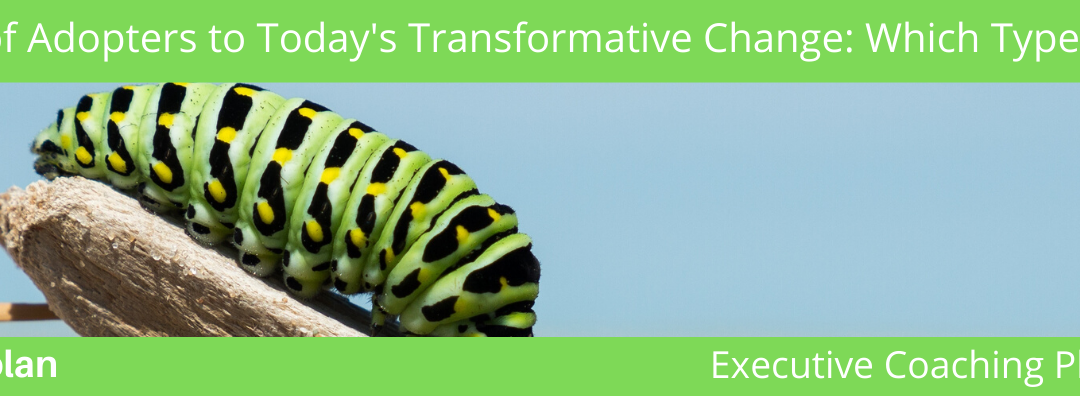New advancements can be difficult to evade, as they sometimes become unavoidable. For those in their forties through sixties, did you buy a cell phone at first launch (remember the bulky car phone?), after people whose opinion you valued told you how convenient they were, after most of your family and friends used one, when not having one put you at a disadvantage, or do you still go without? Other modern transformative products and services include: personal computers, electric cars, novel vaccines, EZ Pass, organic foods, recycling, yoga, exercise, meditation, smart phones, subscription video services, ride sharing, Airbnb, online shopping, and grocery delivery. Think about how long after introduction you purchased any of these products or services and you’ll get an idea of which Consumer Adoption Lifestyle category you belong to, likely indicating where you stand in the prevailing adjustments of the nation and globe. I invite you to identify which group you belong to and how to best leverage yourself, and I’d love to hear suggestions for how you make the most out of your adoption style.
Overview of the 5 Consumer Adoption Groups
Innovators- Innovators are the smallest group of early buyers. They take advantage of new launches and embrace early change. New possibilities and ways of doing things excite these risk takers.
Early Adopters- Early adopters are inclined to try out new products or services, but not before doing research. They want to know what they’re jumping into but are still willing to take risks and adopt early to change. This group tends to be the most influential, most active on social media, and are seen as thoughtful leaders. They rely more on their own opinions than on those of others.
Early Majority- The early majority are risk-averse and want to be sure that their limited resources are spent wisely. While not thought leaders, they’re in touch with thought leaders and will consult them when making purchase decisions.
Late Majority- The late majority are risk-averse and skeptical. They tend to have limited interaction with thought leaders and innovators, and are sometimes less educated, less wealthy, and lower in social class.
Laggards- A laggard buying a product or service typically indicates that the product or service is on a decline, or that they have no way to avoid it. The last to adopt, laggards rarely seek opinions outside of their usually limited social network. They tend to be less familiar with technology and are often older.
Suggestions For You Based on Your Consumer Adoption Lifestyle
Innovators:
- Organize your thoughts – frame the discussion; know your priorities; define the end goal
- Clarify your language – make your words accessible; state your message so that it sticks
- Gather information – know the risks; foresee intended and unintended consequences
- Direct your passion – use your passion to fuel rational and logical choices
Early Adopters:
- Listen to others – seek to understand before trying to be understood
- Activate others – leverage your trustworthiness to engage others
- Focus your efforts – organize; create groups and opportunities for others to join
- Take risks – be uncomfortable and get a little messy; be willing to take a stand
Early Majority:
- Seek counsel – ask the hard questions to those you know and trust
- Find courage – change is scary, but so is staying still
- Take action – meet your comfort level and stretch beyond it
- Expand self-imposed limits – you’re more powerful and resilient than you might credit yourself
Late Majority:
- Expand your awareness – adopt new ways of viewing the world
- Be critical –use your skepticism to evaluate your existing sources of information
- Widen your network – identify new, trustworthy and reliable sources of information
- Weigh the consequences – measure the most likely worst and best outcomes
Laggards:
- Look at the bright side – change equals loss, but it also brings opportunity
- Embrace the moment – notice what’s possible right now, without fear of an unpredictable future
- Ask for what you want – let others know where you are and your needs and wants
- Know that it’s okay – change and the desire to resist it are part of being human
I’d love to say that I’m an innovator, someone who takes risks and leads change, someone who has the foresight and courage to step off the ledge even when I can’t see the bottom, but I’m an early adopter. I’ve often felt like part of the early majority, waiting until a product, service, or cultural change has reached a steady state, but I look back and realize that, relative to the majority, I jumped on board much sooner than I thought. In the end, I probably straddle both.
Regardless of where you belong, have compassion for all adopter groups. We have individual levels of risk-tolerance and readiness for change based on our own reasons and experiences. Be sensitive to this and avoid judging others simply because they aren’t where you think they should be.
